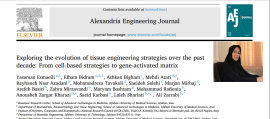The advancement of tissue engineering for regenerating injured tissues and organs has progressed signifcantly in recent years. Various techniques have been used to modify the cells’ microenvironments in the targeted tissue via their extracellular environment for achieving these aims. The 3D structured scaffolds alone or combined with bioactive molecules or genes and cells hold great promise for the development of functional engineered tissues.
As an emerging and state-of-the-art technology in this feld, integrating tissue engineering and gene therapy, known as gene-activated matrix (GAM), has gained immense attention as a promising approach for restoring damaged or dysfunctional tissues’ function and structure. Nonetheless, fabricating GAMs with low cytotoxicity, high transfection effciency, and long-term gene delivery effciency is still challenging. Here we provide a complete overview of different tissue engineering approaches and their ongoing preclinical research trials. Moreover, the GAM strategy with a focus on gene-activated matrix development, faithful application, and future prospects as a tissue repair and regeneration replacement is assayed. The challenges and future research prospects in regenerative medicine are also presented. Eventually, we propose that GAMs offer a basic mechanistic infrastructure for “tissue engineering” to pave the way for clinical translation and achieve personalized regenerative medicine
دسته بندی

